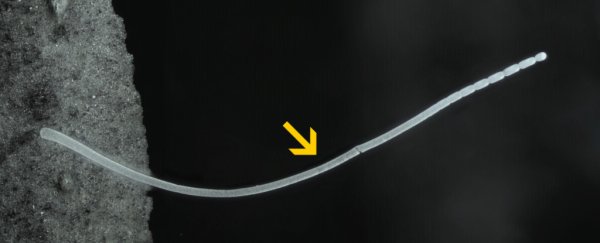A gigantic bacterium found in a mangrove swamp in the Caribbean is by far the largest ever found, and now scientists think they've figured out how it grew to such an enormous size.
This species of bacteria, Thiomargarita magnifica, is 5,000 times larger than most bacteria, and 50 times larger than all other known giant bacteria. (The name Magnifica references the Latin word for 'big' and the French word 'magnifique'.)
"To put it into context, it would be like a human encountering another human as tall as Mount Everest," said California-based marine biologist Jean-Marie Volland who was the lead author of the study.
The centimeter-long T. magnifica was discovered on one of the lush, green islands of Guadeloupe back in 2009.
 Graph showing T. magnifica to scale. (Volland et al., Science, 2022)
Graph showing T. magnifica to scale. (Volland et al., Science, 2022)
At the time of the discovery, marine biology professor Olivier Gros was looking for bacteria that used sulfur to generate energy.
He saw something very odd once he tipped his sample of swamp water into a petri dish, however. Thin, 'vermicelli-like' threads visible to the naked eye were drifting above the leaves and the dirt.
"When I saw them, I thought, 'strange'," he said. "In the beginning I thought it was just something curious, some white filaments that needed to be attached to something in the sediment like a leaf."
More than a decade on, several researchers have peered down microscopes to examine the strange little prokaryotes.
The unusual organism has been poked and prodded using fluorescence, X-rays, electron microscopy, and genome sequencing so that scientists could confirm that it was in fact a gigantic single-cell bacterium.
Reporting their findings in Science today, the team revealed several curious mechanisms that may explain how the unwieldy bacteria pushes the limits of what is theoretically possible in terms of size.
Unlike larger, multicellular organisms – eukaryotes like us that have membrane enclosed organelles in their cells like the nucleus – bacteria belong to a group of organisms called prokaryotes, which are traditionally thought to be "uncompartmentalized bags of enzymes" with no internal membranes to section off genetic material.
T. magnifica bucks that trend by having internal membranes to store DNA and ribosomes.
The researchers decided to call these tiny bacterial organelles 'pepins' (a reference to the small seeds found inside fruits such as watermelon or kiwi).
"Because it segregates its genetic material in membrane-bound organelles, T. magnifica challenges our concept of a bacterial cell," the study authors write.
As T. magnifica has more internal membranes to play with, it can distribute out the protein machines that make the energy currency of cells, ATP (adenosine triphosphate).
Other bacteria don't have internal membranes so the only place to put ATP-generating machines (ATP synthase) is in the cell envelope that encapsulates the entire organism.
Because it's hard to transport this energy very far, this restriction limits the size of most bacteria cells.
Another limitation in most bacteria is that they must be able to double in volume so they can split in half to reproduce.
Unlike other bacteria, T. magnifica simply detaches a small portion of itself to create a daughter cell, therefore overcoming this constraint.
T. magnifica has a much larger genome than other bacteria – 11,788 genes compared with 3,935 genes for the average prokaryote.
A genetic analysis revealed a set of genes for sulfur oxidation and carbon fixation, which suggest that T. magnifica relies on chemoautotrophy (it harvests energy through the oxidation of chemicals).
While "confirmation bias related to viral size prevented the discovery of giant viruses for more than a century", there may be other giant bacteria out there "hiding in plain sight", the authors concluded.
This paper was published in Science.
